
Original Link: https://www.anandtech.com/show/1657
Intel Dual Core Performance Preview Part II: A Deeper Look
by Anand Lal Shimpi on April 6, 2005 12:23 PM EST- Posted in
- CPUs
I'll admit, dual core has me excited for many of the reasons outlined in Part I. A big part is that personally, I've been using multiprocessor systems in my main computer for years. I've always appreciated the benefits of multiprocessor platforms, but recommending one for a desktop user has never been really feasible. Even the cheapest 2P workstation motherboards were at least twice the price of a desktop motherboard, not to mention the cost of the CPUs. The mass market had a short affair with multiprocessing in the days of the ABIT BP6 and the Celeron 300A, but in the grand scheme of things, that was barely a blip on the radar. Now, for the first time, both AMD and Intel are ready to bring the type of robustness of multiprocessor platforms to the desktop with their dual core offerings.
Part I focused on what dual core can offer, but now it's time for a much more practical look. We've never recommended Intel's Extreme Edition line of processors nor AMD's FX series, both supposedly marketed to gamers, but not purchased by any of our gaming readers. The processors that we recommend are usually much better values for the price, and thus, today's comparison isn't based around the most expensive dual core offerings, but rather the cheapest.
A point we made in the first article was that Intel's pricing strategy for dual core is extremely aggressive, with the cheapest 2.8GHz Pentium D soon to be introduced at $241. The problem is that at only 2.8GHz, the Pentium D won't have the strongest single threaded performance, which puts buyers in a sticky situation - do you buy an Athlon 64 3500+ for great single threaded performance or will the Pentium D give you a better overall multitasking experience? Intel doesn't do much to complicate the situation, as the Pentium D 2.8GHz will be close in price to the Pentium 4 630 (3.0GHz), which isn't much of a clock speed advantage. AMD will eventually have competitively priced dual core parts, but right now, AMD doesn't appear to be looking at the mainstream desktop market for dual core Athlon 64 chips.
The three chips mentioned above are the basis of the majority of today's comparison, but the decision is far from clear cut. Let's find out why.
Power Consumption
We'll start with power consumption - the contenders? A 90nm Athlon 64 3500+ vs. the Pentium 4 630 and the dual core 2.8GHz Pentium D. As always, we measured total system power at two states: idle and under a full load. For our full load test, we used a multithreaded application, 3ds max 7, performing the CBALLS2 render test from the SPECapc benchmark.
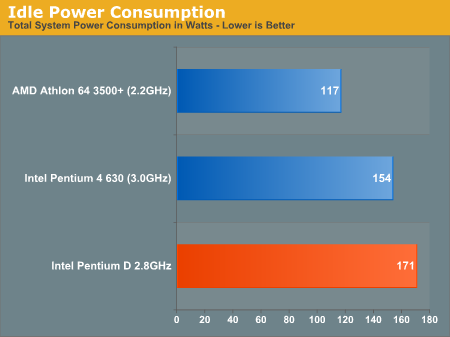
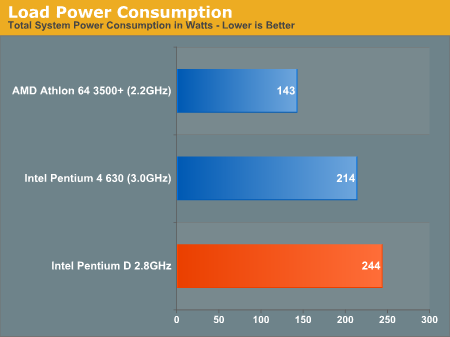
The K8 architecture simply lends itself to lower power consumptions than Intel's high frequency approach to computing with the Pentium 4 (especially Prescott). The move down to 90nm really reduced AMD's power consumption a lot, to the point where the 90nm Athlon 64 3500+ actually consumes less power under full load than the Pentium 4 630 at idle.
The Pentium 4 vs. Pentium D comparison is also interesting, as the 2nd core doesn't add all that much to overall system power consumption. In this case, we're looking at an increase in overall system power consumption by less than 15%. Intel still doesn't win in the power consumption department though; if you want something cool and quiet, AMD is still the way to go.
The Test
Our hardware configurations are similar to what we've used in previous comparisons.
AMD Athlon 64 Configuration
Socket-939 Athlon 64 CPUs
2 x 512MB OCZ PC3200 EL Dual Channel DIMMs 2-2-2-10
NVIDIA nForce4 Reference Motherboard
ATI Radeon X850 XT PCI Express
Intel Pentium 4 Configuration
LGA-775 Intel Pentium 4 and Extreme Edition CPUs
2 x 512MB Crucial DDR-II 533 Dual Channel DIMMs 3-2-2-12
Intel 955X Motherboard
ATI Radeon X850 XT PCI Express
Business Application Performance
Business Winstone 2004
Business Winstone 2004 tests the following applications in various usage scenarios:
- Microsoft Access 2002
- Microsoft Excel 2002
- Microsoft FrontPage 2002
- Microsoft Outlook 2002
- Microsoft PowerPoint 2002
- Microsoft Project 2002
- Microsoft Word 2002
- Norton AntiVirus Professional Edition 2003
- WinZip 8.1
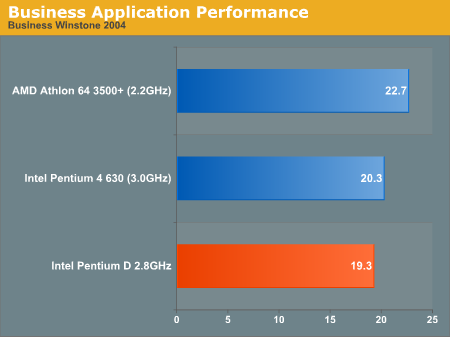
The Pentium 4 and Pentium D perform quite similarly here, but the Athlon 64 3500+ is obviously the strongest performer out of the three when it comes to single threaded business applications.
Office Productivity SYSMark 2004
SYSMark's Office Productivity suite consists of three tests, the first of which is the Communication test. The Communication test consists of the following:
"The user receives an email in Outlook 2002 that contains a collection of documents in a zip file. The user reviews his email and updates his calendar while VirusScan 7.0 scans the system. The corporate web site is viewed in Internet Explorer 6.0. Finally, Internet Explorer is used to look at samples of the web pages and documents created during the scenario."
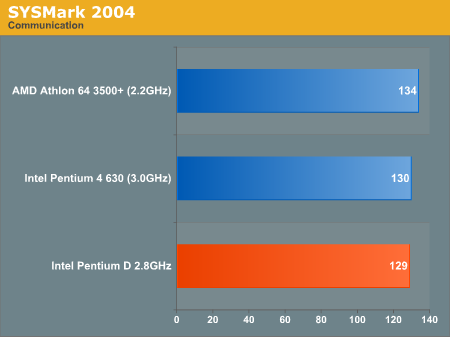
The next test is Document Creation performance:
"The user edits the document using Word 2002. He transcribes an audio file into a document using Dragon NaturallySpeaking 6. Once the document has all the necessary pieces in place, the user changes it into a portable format for easy and secure distribution using Acrobat 5.0.5. The user creates a marketing presentation in PowerPoint 2002 and adds elements to a slide show template."
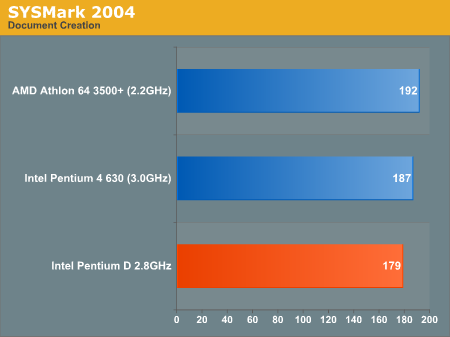
The final test in our Office Productivity suite is Data Analysis, which BAPCo describes as:
"The user opens a database using Access 2002 and runs some queries. A collection of documents are archived using WinZip 8.1. The queries' results are imported into a spreadsheet using Excel 2002 and are used to generate graphical charts."
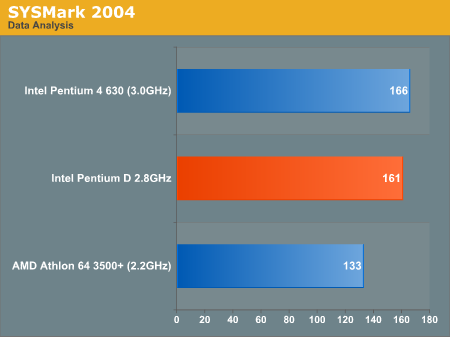
SYSMark paints a much more evenly matched picture between AMD and Intel in the Office Productivity suite. What's interesting is that even AMD recommends SYSMark 2004 as the best overall system performance test for multi-core desktop CPUs.
Business Winstone 2004 includes a multitasking test as a part of its suite, which does the following:
"This test uses the same applications as the Business Winstone test, but runs some of them in the background. The test has three segments: in the first, files copy in the background while the script runs Microsoft Outlook and Internet Explorer in the foreground. The script waits for both foreground and background tasks to complete before starting the second segment. In that segment, Excel and Word operations run in the foreground while WinZip archives in the background. The script waits for both foreground and background tasks to complete before starting the third segment. In that segment, Norton AntiVirus runs a virus check in the background while Microsoft Excel, Microsoft Project, Microsoft Access, Microsoft PowerPoint, Microsoft FrontPage, and WinZip operations run in the foreground."
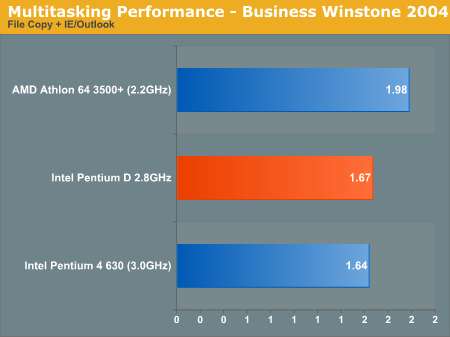
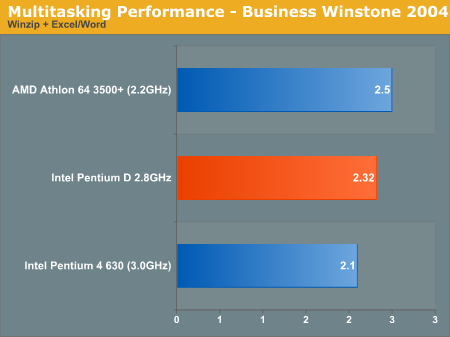
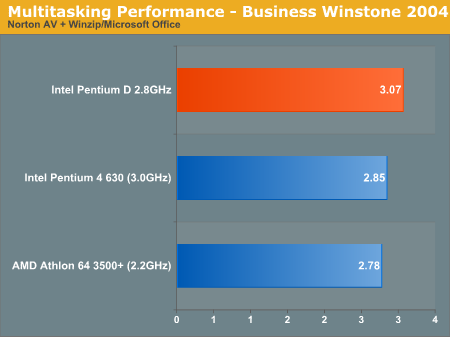
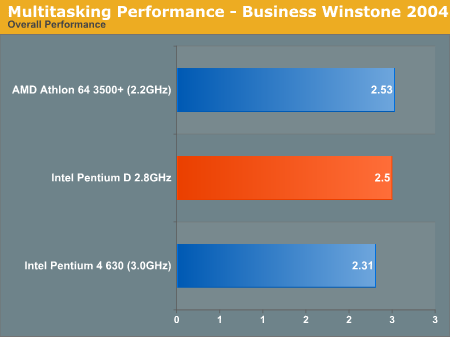
The multitasking tests show the Pentium D 2.8GHz and the Athlon 64 3500+ as equal competitors, with AMD winning the first two tests and Intel winning the last. This just goes to show you that not all multitasking will be immediately faster on a dual core chip.
Multimedia Content Creation Performance
MCC Winstone 2004
Multimedia Content Creation Winstone 2004 tests the following applications in various usage scenarios:
- Adobe® Photoshop® 7.0.1
- Adobe® Premiere® 6.50
- Macromedia® Director MX 9.0
- Macromedia® Dreamweaver MX 6.1
- Microsoft® Windows MediaTM Encoder 9 Version 9.00.00.2980
- NewTek's LightWave® 3D 7.5b
- SteinbergTM WaveLabTM 4.0f
All chips were tested with Lightwave set to spawn 4 threads.

Once again, AMD's 3500+ takes the lead in the MCC tests, despite the benefits of dual core in the area.
ICC SYSMark 2004
The first category that we will deal with is 3D Content Creation. The tests that make up this benchmark are described below:
"The user renders a 3D model to a bitmap using 3ds max 5.1, while preparing web pages in Dreamweaver MX. Then the user renders a 3D animation in a vector graphics format."
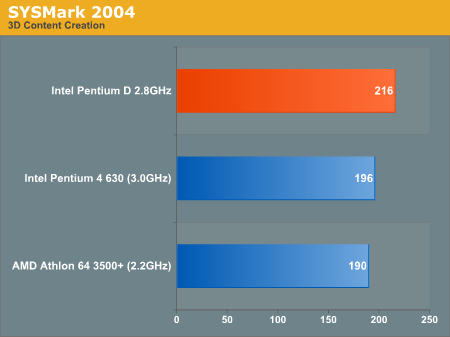
Next, we have 2D Content Creation performance:
"The user uses Premiere 6.5 to create a movie from several raw input movie cuts and sound cuts and starts exporting it. While waiting on this operation, the user imports the rendered image into Photoshop 7.01, modifies it and saves the results. Once the movie is assembled, the user edits it and creates special effects using After Effects 5.5."
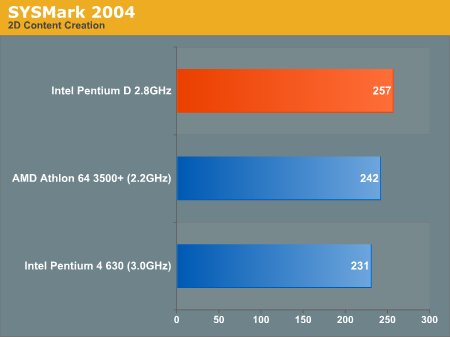
The Internet Content Creation suite is rounded up with a Web Publishing performance test:
"The user extracts content from an archive using WinZip 8.1. Meanwhile, he uses Flash MX to open the exported 3D vector graphics file. He modifies it by including other pictures and optimizes it for faster animation. The final movie with the special effects is then compressed using Windows Media Encoder 9 series in a format that can be broadcast over broadband Internet. The web site is given the final touches in Dreamweaver MX and the system is scanned by VirusScan 7.0."
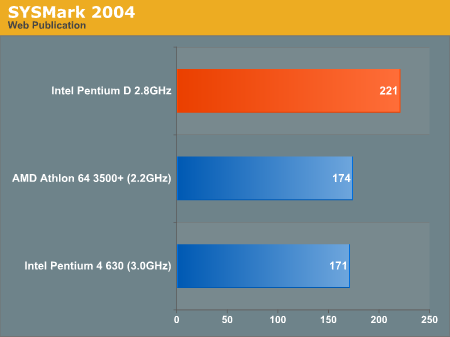
SYSMark shows the exact opposite with the Pentium D taking the lead in all three of the ICC tests.
Encoding Performance
These new dual core CPUs are supposed to usher in a new era of media rich application usage models. They are supposed to enable us to do things that we were never able to do before. Let's find out if that's true or not...
First, we start off with iTunes to test MP3 encoding performance. We took a 12MB .wav file of our own creation and encoded it to a 192kbps MP3 file, measuring how long it took to encode the file.
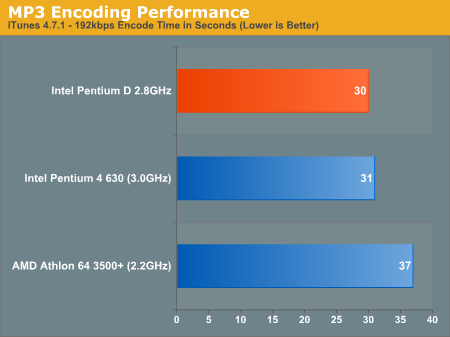
DivX Encoding Performance
Our DivX tests from previous CPU reviews have shown a pretty sizeable improvement due to Hyper Threading, so we expected a similarly impressive gain due to dual core:
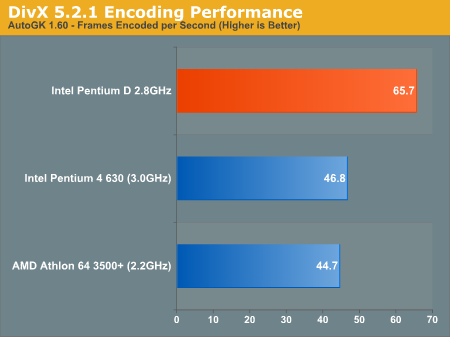
XviD Encoding Performance
The Pentium D is the clear winner in all of the encoding tests; the presence of a second core only increases Intel's strengths in the area.
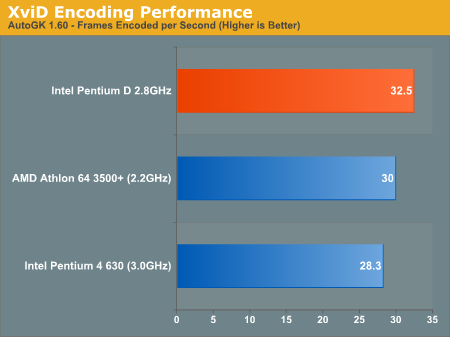
Windows Media Video 9 Encoding Performance

3D Rendering Performance
Intel's Pentium D 2.8 is the clear winner in all of the 3ds max 7 rendering tests:
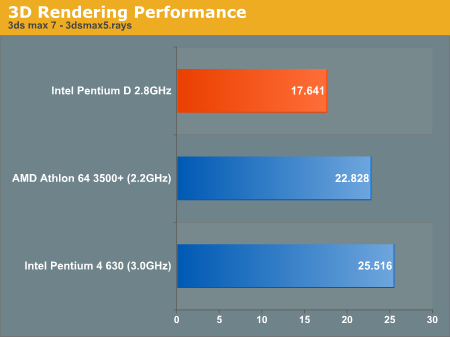
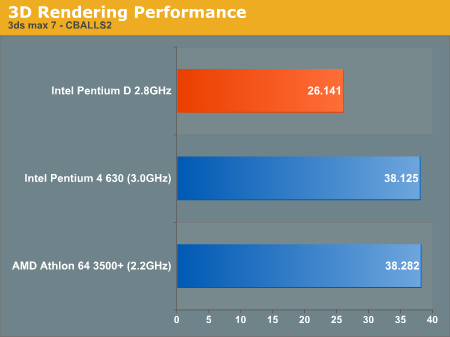
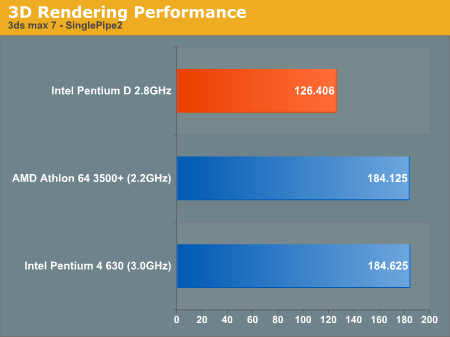
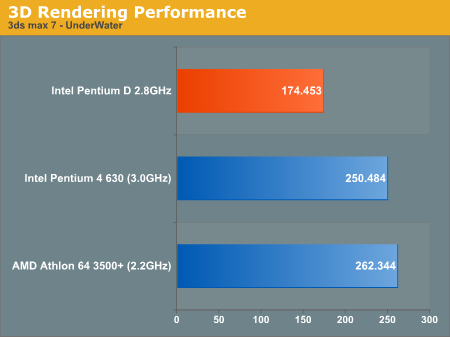
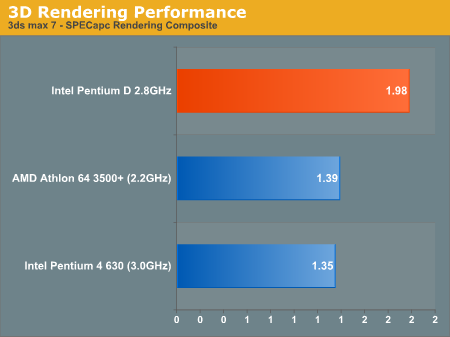
Gaming Performance
Single threaded gaming performance is, as we mentioned in the first article, no different than the single core Pentium 4 of the same clock speed. And as we know from all of our previous comparisons, the Athlon 64 is the clear choice for single threaded gaming performance.
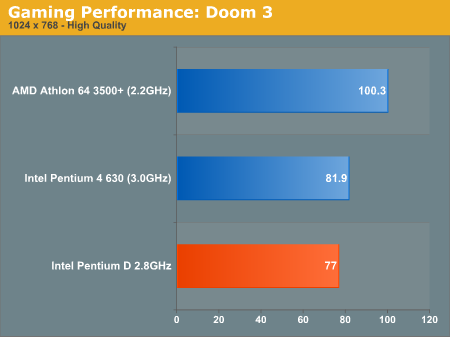
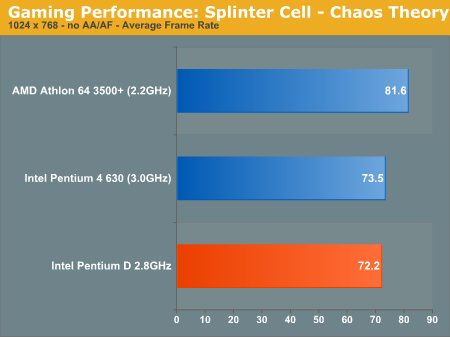
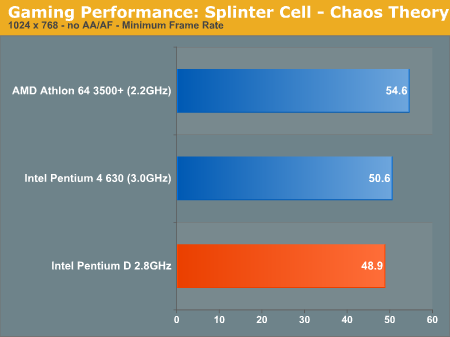
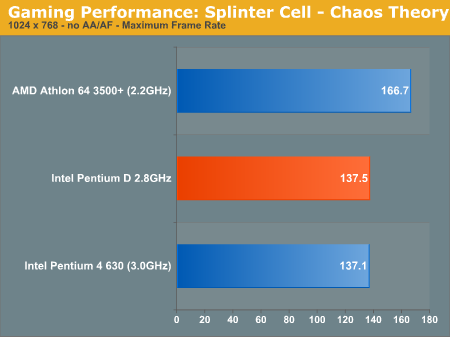
Multitasking Performance
As we discovered in the first article, multitasking performance requires a slightly different approach to benchmarking methodology. While for single application performance in which we test with a system that's in a very clean state with nothing but the benchmark and drivers loaded, for our multitasking tests, we have the system configured as what a real system would be. That means tons of programs and lot's of tasks running in the background. If you missed Part I, here's a quick recap of what our system configuration is like for our multitasking tests; the following applications were installed:
Daemon Tools
Norton AntiVirus 2004 (with latest updates)
Firefox 1.02
DVD Shrink 3.2
Microsoft AntiSpyware Beta 1.0
Newsleecher 2.0
Visual Studio .NET 2003
Macromedia Flash Player 7
Adobe Photoshop CS
Microsoft Office 2003
3ds max 7
iTunes 4.7.1
Trillian 3.1
DivX 5.2.1
AutoGK 1.60
Norton Ghost 2003
Adobe Reader 7
What's important about that list is that a handful of those programs were running in the background at all times, primarily Microsoft's AntiSpyware Beta and Norton AntiVirus 2004. Both the AntiSpyware Beta and NAV 2004 were running with their real-time protection modes enabled, to make things even more real world.
Multitasking Scenario 1: DVD Shrink
For this test, we used DVD Shrink, one of the simplest applications available to compress and re-encode a DVD to fit on a single 4.5GB disc. We ran DVD Decrypt on the Star Wars Episode VI DVD so that we had a local copy of the DVD on our test bed hard drive (in a future version of the test, we may try to include DVD Decrypt performance in our benchmark as well). All of the DVD Shrink settings were left at default, including telling the program to assume a low priority, a setting that many users check in order to be able to do other things while DVD Shrink is working.
Next, we did the following:
1) Open Firefox and load the following web pages in tabs (we used local copies of all of the web pages):
We kept the browser on the AT front page.
2) Open iTunes and start playing the latest album of avid AnandTech reader 50 Cent on repeat all.
3) Open Newsleecher.
4) Open DVD Shrink.
5) Login to our news server and start downloading headers for our subscribed news groups.
6) Start backup of Star Wars Episode VI - Return of the Jedi. All default settings, including low priority.
DVD Shrink was the application in focus. This matters because by default, Windows gives special scheduling priority to the application currently in the foreground (we will test what happens when it's not in the foreground later in this article). We waited until the DVD Shrink operation was complete and recorded its completion time. Below are the results:
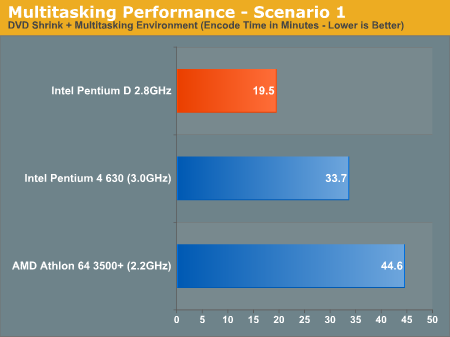
The results here aren't too surprising. With dual core, you can get a lot more done at once, so the Pentium D 2.8 cuts the DVD Shrink encode time by about half when compared to the Athlon 64 3500+.
There is one element that caught us off guard, however. When looking at these numbers, we noticed that they were unusually high compared to the numbers from our first article. Yet, we ran and re-ran the numbers and had fairly consistent results. Even running the CPUs at the same speeds as in our first article yielded lower performance than what we saw in that piece. Comparatively, the processors all performed the same with reference to each other, but the DVD Shrink times were all noticeably higher. So, we started digging, and what we uncovered was truly interesting.
The Impact of NCQ on Multitasking Performance
Just under a year ago, we reviewed Maxtor's MaXLine III, a SATA hard drive that boasted two very important features: a 16MB buffer and support for Native Command Queuing (NCQ). The 16MB buffer was interesting as it was the first time that we had seen a desktop SATA drive with such a large buffer, but what truly intrigued us was the drive's support for NCQ. The explanation of NCQ below was from our MaXLine III review from June of 2004:
Hard drives are the slowest things in your PC and they are such mostly because they are the only component in your PC that still relies heavily on mechanics for its normal operation. That being said, there are definite ways of improving disk performance by optimizing the electronics that augment the mechanical functions of a hard drive.
Hard drives work like this: they receive read/write requests from the chipset's I/O controller (e.g. Intel's ICH6) that are then buffered by the disk's on-board memory and carried out by the disk's on-board controller, making the heads move to the correct platter and the right place on the platter to read or write the necessary data. The hard drive is, in fact, a very obedient device; it does exactly what it's told to do, which is a bit unfortunate. Here's why:
It is the hard drive, not the chipset's controller, not the CPU and not the OS that knows where all of the data is laid out across its various platters. So, when it receives requests for data, the requests are not always organized in the best manner for the hard disk to read them. They are organized in the order in which they are dispatched by the chipset's I/O controller.
Native Command Queuing is a technology that allows the hard drive to reorder dynamically its requests according to the location of the requests on a platter. It's like this - say you had to go to the grocery store and the drug store next to it, the mall and then back to the grocery store for something else. Doing it in that order would not make sense; you'd be wasting time and money. You would naturally re-order your errands to grocery store, grocery store, drug store and then the mall in order to improve efficiency. Native Command Queuing does just that for disk accesses.
For most desktop applications, NCQ isn't necessary. Desktop applications are mostly sequential in nature and exhibit a high degree of spatial locality. What this means is that most disk accesses for desktop systems occur around the same basic areas on a platter. Applications store all of their data around the same location on your disk as do games, so loading either one doesn't require many random accesses across the platter - reducing the need for NCQ. Instead, we see that most desktop applications benefit much more from higher platter densities (more data stored in the same physical area on a platter) and larger buffers to improve sequential read/write performance. This is the reason why Western Digital's 10,000 RPM Raptor can barely outperform the best 7200 RPM drives today.
Times are changing, however, and while a single desktop application may be sequential in nature, running two different desktop applications simultaneously changes the dynamics considerably. With Hyper Threading and multi-core processors being the things of the future, we can expect desktop hard disk access patterns to begin to slightly resemble those of servers - with more random accesses. It is with these true multitasking and multithreading environments that technologies such as NCQ can improve performance.
In the Maxtor MaXLine III review, we looked at NCQ as a feature that truly came to life when working in multitasking scenarios. Unfortunately, finding a benchmark to support this theory was difficult. In fact, only one benchmark (the first Multitasking Business Winstone 2004 test) actually showed a significant performance improvement due to NCQ.
After recovering from Part I and realizing that my nForce4 Intel Edition platform had died, I was hard at work on Part II of the dual core story. For the most part, when someone like AMD, Intel, ATI or NVIDIA launches a new part, they just send that particular product. In the event that the new product requires another one (such as a new motherboard/chipset) to work properly, they will sometimes send both and maybe even throw in some memory if that's also a more rare item. Every now and then, one of these companies will decide to actually build a complete system and ship that for review. For us, that usually means that we get a much larger box and we have to spend a little more time pulling the motherboard out of the case so we can test it out on one of our test benches instead - obviously, we never test a pre-configured system supplied by any manufacturer. This time around, both Intel and NVIDIA sent out fully configured systems for their separate reviews - two great huge boxes blocking our front door now.
When dissecting the Intel system, I noticed something - it used a SATA Seagate Barracuda 7200.7 with NCQ support. Our normal testbed hard drive is a 7200.7 Plus, basically the same drive without NCQ support. I decided to make Part I's system configuration as real world as possible and I used the 7200.7 with NCQ support. So, I used that one 7200.7 NCQ drive for all of the tests for Monday's review. Normally, only being able to run one system at a time would be a limitation. But given how much work I had to put into creating the tests, I wasn't going to be able to run multiple things at the same time while actually using each machine, so this wasn't a major issue. The results turned out as you saw in the first article and I went on with working on Part II.
For Part II, I was planning to create a couple more benchmarks, so I wasn't expecting to be able to compare things directly to Part I. I switched back to our normal testbed HDD, the 7200.7 Plus. Using our normal testbed HDD, I was able to set up more systems in parallel (since I had more HDDs) and thus, testing went a lot quicker. I finished all of the normal single threaded application benchmarks around 3AM (yes, including gaming tests) and I started installing all of the programs for my multitasking scenarios.
When I went to run the first multitasking scenario, I noticed something was very off - the DVD Shrink times were almost twice what they were in Monday's review. I spent more time working with the systems and uncovered that Firefox and iTunes weren't configured identically to the systems in Monday's review, so I fixed those problems and re-ran. Even after re-running, something still wasn't right - the performance was still a lot slower. It was fine in all other applications and tests, just not this one. I even ran the second multitasking scenario from Monday's review and the performance was dead on - something was definitely up. Then it hit me...NCQ.
I ghosted my non-NCQ drive to the NCQ drive and re-ran the test. Yep, same results as Monday. The difference was NCQ! Johan had been pushing me to use a Raptor in the tests to see how much of an impact disk performance had on them, and the Raptor sped things up a bit, but not nearly as much as using the 7200.7 did. How much of a performance difference? The following numbers use the same configuration from Monday's article, with the only variable being the HDD. I tested on the Athlon 64 FX-55 system:
Seagate Barracuda 7200.7 NCQ - 25.2 minutes
Seagate Barracuda 7200.7 no NCQ - 33.6 minutes
Western Digital Raptor WD740 - 30.9 minutes
The performance impact of NCQ is huge. But once again, just like the first NCQ article, this is the only test that I can get to be impacted by NCQ - the other Multitasking Scenarios remain unchanged. Even though these numbers were run on the AMD system, I managed to get similar results out of the Intel platform. Although, for whatever reason, the Intel benchmarks weren't nearly as consistent as the AMD benchmarks. Given that we're dealing with different drive controllers and vastly different platforms, there may be many explanations for that.
At first, I thought that this multitasking scenario was the only one where NCQ made an impact, but as you'll find out later on in this article, that's not exactly true.
Multitasking Scenario 2: File Compression
For our next test, we simulated what would happen if we performed two disk intensive tasks at the same time: zipping a file while importing a 260MB PST file into Outlook 2003.
We ran the same Firefox and iTunes tasks from the last test again, and then did the following:
1) Open Outlook.
2) Start importing 260MB PST.
3) Start WinRAR.
4) Archive 130MB test file.
WinRAR remained the application in focus during this test.
Here, we looked at two metrics: how long it took WinRAR to compress our test file, and how many emails were imported into Outlook during the time that WinRAR was archiving. Let's have a look at the results:
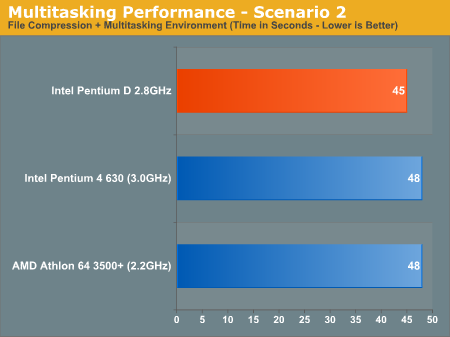
The Pentium D did slightly better than the Athlon 64 in the WinRAR test, but as expected, had well over twice as many emails imported into Outlook by the time that the test was over. Even the Pentium 4 630 also managed to import significantly more emails than the AMD platform.
Multitasking Scenario 3: Web Browsing
For our final benchmark, we decided to switch things up a bit and keep Firefox as our foreground application while background tasks ran. To make things even more stressful, we had no less than 12 tabs open in Firefox, with our main tab being IGN's PSP website - which happens to be very Flash heavy.
The iTunes and Newsleecher tasks from the first test scenario were also present in this one, plus we did the following:
Open Outlook, immediately import 130MB PST file and immediately switch app focus to Firefox.
We then recorded the total time required to import the new PST while Firefox was our foreground application.
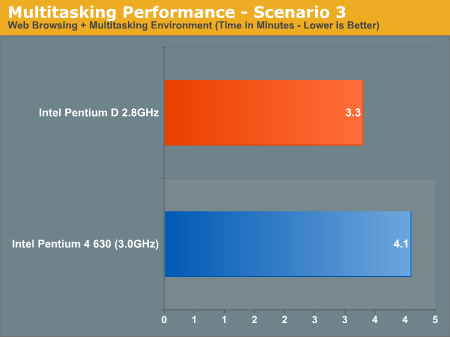
As we discovered in our first article, the AMD platform just can't make it under this test - the load (particularly the Flash load) makes the Athlon 64 import process take well over four times as long as the import process on either of the Intel systems.
In the Intel camp, obviously dual core wins out and by a very reasonable margin of victory. The Pentium D 2.8 takes around 19% less time to import the PST into Outlook than the higher clocked, larger cache Pentium 4 630.
Gaming Multitasking Scenario 1: Heavy Downloading
In the first article, we ran under the assumption that gamers wanted to have as little running in the background while playing a game. While that ended up being true for a lot of folks, we also received quite a bit of feedback asking for some pretty intense multitasking tests while gaming. The requests were far more intense than even the most strenuous setup that we came up with, but because of the demand for such benchmarks, we spent some time putting a few together. Note that this is by no means supposed to be an exhaustive comparison of all gaming scenarios. We are working on creating more and we apologize if your desired scenario didn't make it into this review, but keep sending in suggestions on how you play and we'll do our best to model some benchmarks after how you use your computer.
The first test basically performs all of the tasks from our first Multitasking Scenario, with the exception of DVD Shrink. We have Firefox loaded, but with all 12 tabs from the third test, iTunes is running and playing a playlist, and Newsleecher is downloading headers. We kept Newsleecher in this test simply because it's the best way for us to be able to have a fairly CPU/disk intensive downloading task running in the background while still maintaining some semblance of repeatability. So, replace Newsleecher with BitTorrent or any other resource-consuming downloading that you may be doing and you're good to go.
Of course, Norton AntiVirus 2004 and Microsoft's AntiSpyware Beta were also running in the background.
First, we ran our Doom 3 benchmark:
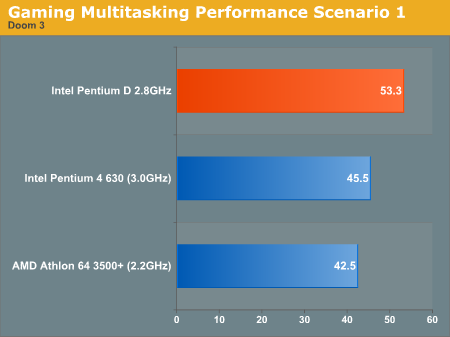
The tables have now been turned. While the Athlon 64 held a 30% lead with no multitasking, it's now outpaced by both Intel processors, with the Pentium D holding a 25% performance advantage.
It's no surprise that having two cores yield less of a performance impact to having more applications run in the background.
Doom 3 was actually quite playable on both machines; although, loading the game and the levels took a lot longer on the A64, and there's a lot of stuttering during the actual game.
The Pentium 4 platform was quite a bit better, but there is a definite reduction in performance. Obviously, the Pentium D did the best out of the group, but you still notice the performance drop.
Next, we ran the Splinter Cell: Chaos Theory benchmark:
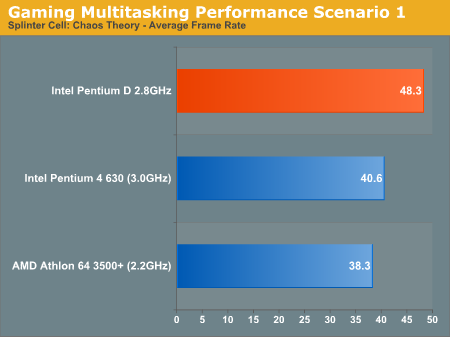
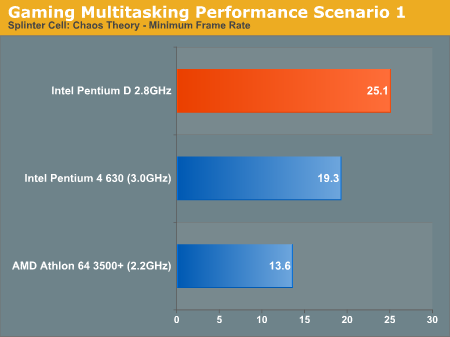
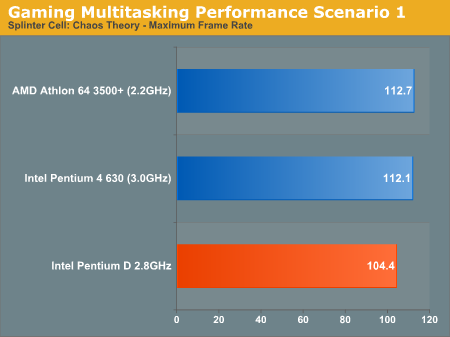
Once again, the Pentium D is ahead of the Athlon 64, but the improvement in minimum frame rates is particularly impressive. The Pentium D offers twice the minimum frame rate of the Athlon 64 in this scenario.
Gaming Multitasking Scenario 1 w/ NCQ
We noticed that many of the pauses during GMT1 were disk related, so I tried using the 7200.7 drive with NCQ support. The difference was very perceivable. The number of stalls was reduced significantly as is evidenced by the increase in average frame rates.

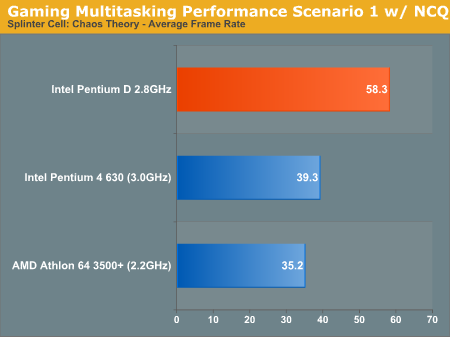
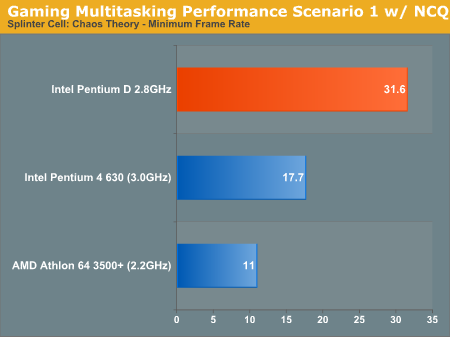
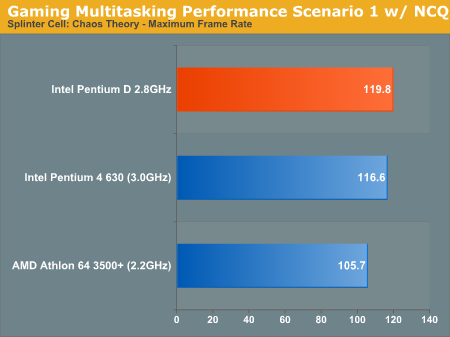
On the Pentium D, we saw the largest increase in performance while playing Splinter Cell; the game never stalled, not even once.
GMT1 with NCQ wasn't nearly as successful on the Pentium 4 630. The game was still way too choppy for regular gameplay.
Gaming Multitasking Scenario 2: DVD Shrink
For our next test, we wanted to do something a little less strenuous, so we only ran one background task: DVD Shrink. We left DVD Shrink at its default low priority and went ahead with our benchmarks:
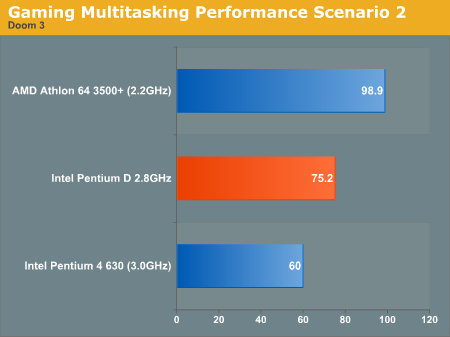
Thanks to DVD Shrink behaving and running with a low priority, our gameplay was largely unaffected on the Athlon 64. The performance dropped less than 3% in Doom 3.
What's very interesting, however, is that the Pentium 4 630 takes a huge performance hit with DVD Shrink running in the background. Despite being set to a low priority, since Hyper Threading allows both the DVD Shrink thread and Doom 3 thread to execute concurrently, they both contend for the same microprocessor execution resources. This happens to be one case where Hyper Threading is actually very bad for performance, as the OS has no idea that its scheduling is actually hurting the CPU's performance severely.
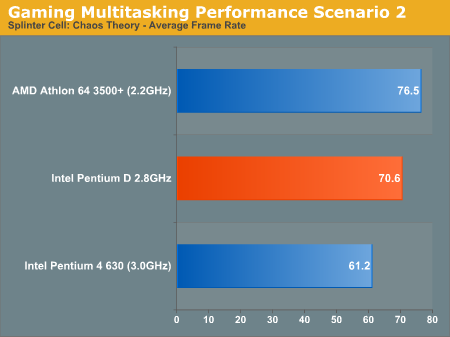
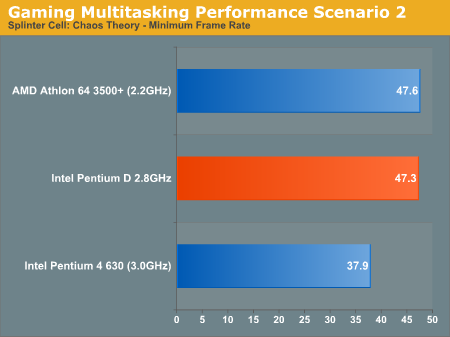
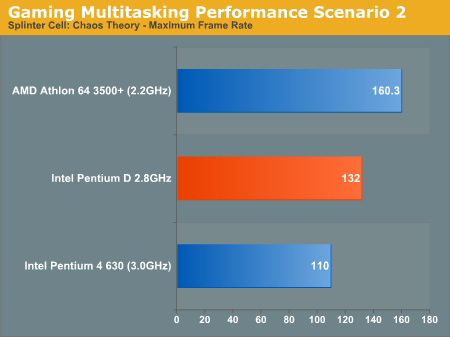
The performance gap between the Pentium D and the Athlon 64 actually closes quite a bit under Splinter Cell. The minimum frame rates are now identical, although the maximum frame rates are clearly higher on the AMD system.
Once again, HT has a negative impact in this case on the Pentium 4 630.
Just for kicks, we decided to turn off DVD Shrink's low priority setting to see what impact that would have on performance. The low priority mode of DVD Shrink basically makes it transparent to gaming. Unchecking this option definitely changes things, it wouldn't even start on the Athlon 64 system.
It eventually ran on the Pentium D system after waiting several minutes for it to start, and even then, performance wasn't acceptable. It just goes to show you that dual core isn't Superman; it does have its limits.
Final Words
The point of this article was to present you with the choice that you'll be making, should you decide to upgrade to a new system in the coming months; the choice between very fast single task performance (and to some extent, light multitasking performance) or more responsive, heavy multitasking performance. No one is really exempt from this decision and you'll have to come to the decision based on your own needs.
We've shown the Athlon 64 to have extremely solid single threaded performance. With the exception of our encoding tests, the Athlon 64 really can't be beat when it comes to running a single application.
The tables are turned as soon as multitasking is introduced, where you can't beat the fact that the Pentium D is able to fulfill the needs of more applications running in the background.
So, the question quickly becomes, how heavy of a multitasker are you? If you're primarily a gamer and you find your gaming performance gets bogged down at all by the tasks you're running in the background, then dual core will most likely outweigh the benefits of a strong single core CPU. If not, then your answer is clear: go for the faster single core.
For encoding performance, you still can't beat the Pentium D. Even a dual core Athlon 64 isn't going to help enough in that area.
To characterize all other non-gaming, non-encoding performance is extremely difficult. For the most part, if you're doing a lot of things at the same time or if you have a lot of applications eating up CPU time - you're better off with the Pentium D. If you are a much cleaner operator and don't have all that much going on, then a single core CPU will still be your best bet; and what better single core to have than the Athlon 64.
The surprise here is the impact of NCQ on multitasking performance. The difference in two of our tests was not only measurable, but also quite noticeable in real world usage. Given that NCQ is quickly becoming a "free" feature of new hard drives, it's a feature that we'd strongly recommend to have in your next system. It doesn't improve performance across the board, but it doesn't hurt things and when it does work, it works extremely well.
With all this excitement, we still have to keep ourselves grounded in the thought that dual core isn't here yet; it's still as much as two months away. For AMD, as we've known all along, the wait is going to be a bit longer on the desktop. The workstation and server markets will be serviced by AMD first, and we will have a look at workstation/server dual core performance as soon as AMD launches those parts. It's looking like, at least on the desktop, if you want dual core at a reasonable price point, your only option will be Intel. But the prospect of more affordable dual core chips out of AMD in 2006 is quite exciting as well.
A dual core Athlon 64 solves a lot of our dilemmas simply because you get stronger single threaded performance than the Pentium D (in everything but encoding) while also getting the multitasking benefits of dual core.
For Intel, the Pentium D is a saving grace - it's the first time that we've been interested in any processor based on the Prescott core. It's also perfect timing; if it weren't for the Pentium D, we'd have no interest in the Intel 945 and 955 chipsets, and definitely not in NVIDIA's new nForce4 SLI Intel Edition product. With that said, it should be pretty clear what our next article in this series will be...







